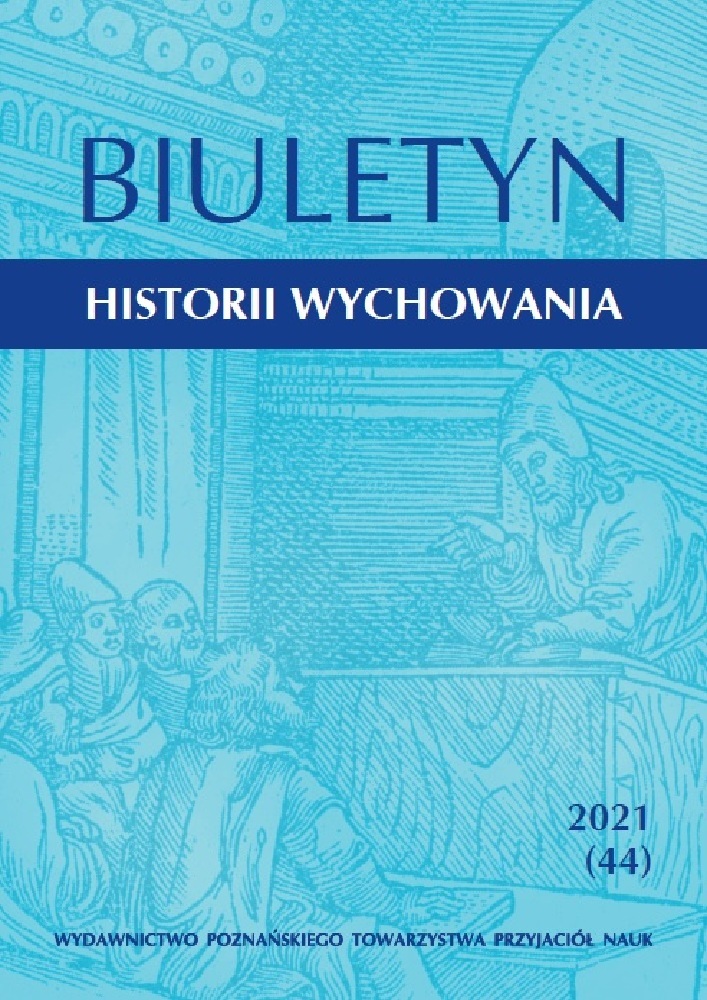Konceptualna ilustracja naukowa Fritza Kahna
DOI:
https://doi.org/10.14746/bhw.2021.44.9Słowa kluczowe:
conceptual scientific illustration, visual history,, istory of instructional media, isual education, Fritz Kahn, infographic concepts, modernity, graphic designAbstrakt
The paper outlines the origin, development, applications, and impact of conceptual scientific illustration, developed in the early 20th century by Fritz Kahn, a German gynecologist, publisher and popularizer of science. These illustrations explains how things work via concepts, metaphors and illusion. This is in contrast to the descriptive anatomical and natural illustrations of 19th-century paintings which show what things look like. The article presents the systematics of the main types of illustrations by F. Kahn and reflects on reception thereof.
Pobrania
Bibliografia
Bolter J.D., Przestrzeń pisma. Komputery, hipertekst i remediacja druku, Korporacja Ha!art - Miejskie Centrum Kultury w Bydgoszczy, Bydgoszcz 2014.
Borck C., Communicating the Modern Body: Fritz Kahn's Popular Images of Human Physiology as an Industrialized World, "Canadian Journal of Communication" 2007, 32. https://doi.org/10.22230/cjc.2007v32n3a1876 DOI: https://doi.org/10.22230/cjc.2007v32n3a1876
Cairo A., The functional art . An introduction to information graphics and visualization, New Riders 2013.
Debschitz U., von Debschitz T., Fritz Kahn Infographics Pioneer, Taschen, Kohln 2013.
Debschitz U., von Debschitz T., Fritz Kahn Infographics Pioneer, Taschen, Kohln, 2017.
Doudova H., Image Factories: Infographics 1920-1945: Fritz Kahn, Otto Neurath et al, "Paperback" 2018, June, 26.
Droste M., Bauhaus 1919-1933, Taschen, Berlin 2006.
Dupre B., 50 wielkich teorii, które powinieneś znać, Wydawnictwo Naukowe PWN, Warszawa 2011.
Corbusier E.C., La maison est une machine à inhabiter, wyd. ang. z 1931.
Gropius W., Pełnia architektury, Wydawnictwo Karakter, Kraków 2014.
Heller S., Chwast S., Graphic style. From Victorian to digital, Harry N. Abrams, New York 2000.
Hopwood N., Producing a Socialist Popular Science in the Weimar Republic, "History Workshop Journal" 1996, 41. https://doi.org/10.1093/hwj/1996.41.117 DOI: https://doi.org/10.1093/hwj/1996.41.117
Kahn F., Das Leben des Menschen . Eine volkstümliche Anatomie, Biologie, Physiologie und Entwicklungsgeschichte des Menschen, Franckh'sche Verlangshandlung, Stuttgard 1923, t. 1.
Kahn F., Das Leben des Menschen . Eine volkstümliche Anatomie, Biologie, Physiologie und Entwicklungsgeschichte des Menschen Franckh'sche Verlangshandlung, Stuttgard 1925, t. 2.
Kahn F., Das Leben des Menschen . Eine volkstümliche Anatomie, Biologie, Physiologie und Entwicklungsgeschichte des Menschen Franckh'sche Verlangshandlung, Stuttgard 1926, t. 3.
Kahn F., Das Leben des Menschen . Eine volkstümliche Anatomie, Biologie, Physiologie und Entwicklungsgeschichte des Menschen Franckh'sche Verlangshandlung, Stuttgard 1929, t. 4.
Kahn F., Das Leben des Menschen . Eine volkstümliche Anatomie, Biologie, Physiologie und Entwicklungsgeschichte des Menschen Franckh'sche Verlangshandlung, Stuttgard 1931, t. 5.
Kahn F., Der Mensch als Industriepalast, Das Leben des Menschen band 3 (Stuttgart: Franckh'sche Verlagshandlung, 1926); plakat z wewnętrznej kieszeni okładki, chromolitografia offsetowa, rozm. 48 × 94 cm.
Kahn P., Lenk K., To Show and Explain: The information Graphics of Stevin and Comenius, "Visible Language" 1992 (Summer-Autumn), 26, 3-4.
Kolesar Z., Mrowczyk J., Historia projektowania graficznego, Wydawnictwo Karakter, Kraków 2018 .
Kruszewski K., Sztuka nauczania. Czynności nauczyciela, Wydawnictwo Naukowe PWN, Warszawa 2005 .
Leszkowicz M., Czytanie informacyjne . Infografiki w procesach poznawczych, Wydawnictwo Naukowe UAM, Poznań 2020. https://doi.org/10.14746/amup.9788323238027 DOI: https://doi.org/10.14746/amup.9788323238027
Michnik A., Reprezentacje ludzkiego organizmu w ilustracjach publikacji Fritza Kahna z okresu Republiki Weimarskiej, "Rocznik Historii Sztuki" 2014, t. 39.
Mijksenaar P., Visual function: An introduction to information design, Princeton Architectural Press, Rotterdam 1997.
Norman D.A., Dizajn na co dzień, Wydawnictwo Karakter, Kraków 2018.
Norman D.A., Wzornictwo i emocje . Dlaczego kochamy lub nienawidzimy rzeczy powszednie, Wydawnictwo Arkady, Warszawa 2015.
Sappol M., Body Modern: Fritz Kahn, Scientific Illustration, and the Homuncular Subject, Minneapolis: University of Minnesota Press, Minnesota 2017.
Sotorkerson P.K., Contexand interpretation: designing information for flexible use, University of Massachusetts, California 1994.
Sweller J., Cognitive Load Theory, Learning Difficulty and Instructional Design, Learning and Instruction, 1994, 4. https://doi.org/10.1016/0959-4752(94)90003-5 DOI: https://doi.org/10.1016/0959-4752(94)90003-5
Sweller J., van Merriënboer J.J.G., Paas F., Cognitive architecture and instructional design, "Educational Psychology Review" 1998, 10. https://doi.org/10.1023/A:1022193728205 DOI: https://doi.org/10.1023/A:1022193728205
Tufte E.R., Beautiful evidence, Graphics Press, Connecticut 2006.
Tufte E.R., Visual explanations: Images and quantities. Evidence and narrative, Graphics Press, Cheshire 1997. https://doi.org/10.1063/1.168637 DOI: https://doi.org/10.1063/1.168637
https://www.nybooks.com/articles/2014/04/24/storm-over-the-brain/ [dostęp: 15.09.2021].
https://www.gutenberg.org/files/1185/1185-h/1185-h.htm [dostęp: 14.09.2021].
Pobrania
Opublikowane
Jak cytować
Numer
Dział
Licencja
Prawa autorskie (c) 2023 Mateusz Leszkowicz

Utwór dostępny jest na licencji Creative Commons Uznanie autorstwa – Użycie niekomercyjne – Bez utworów zależnych 4.0 Międzynarodowe.
Zgodne z normami prawa polskiego.









